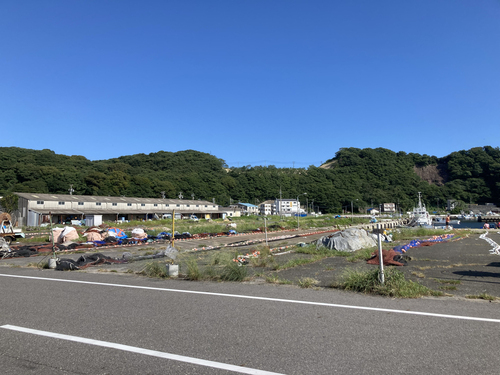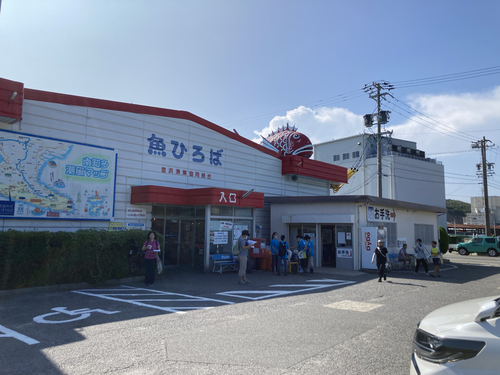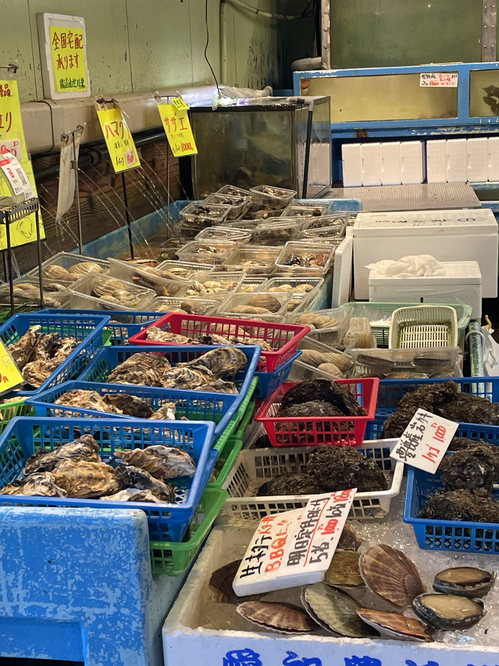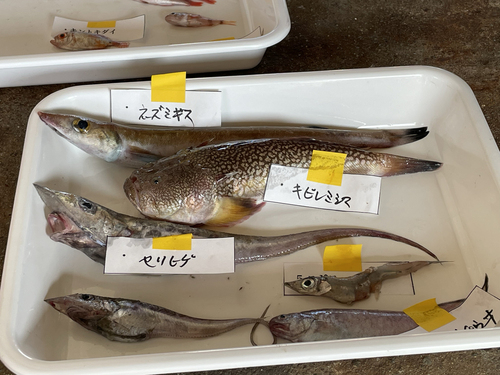Introduction
Along Japan's coastline, the underwater world teems with extraordinary life forms. Fish in the deep sea live in dark, extreme conditions where there is little sunlight. Over the millennia, they have developed distinctive features to flourish in the darkness. Yet, most people never experience these remarkable creatures directly. I was excited, therefore, to find a flyer from the Nagoya University Museum (NUM) that offered a field trip to see and touch deep-sea creatures.
On September 18, 2023, NUM welcomed participants to a field trip at Toyohama Fishing Port, where they could witness local fishers sorting deep water fish. The aim of the field trip was to give participants a rare chance to see small fish species up close, which are usually only seen in books or on TV. This open-to-the-public event is just one of the many engaging activities that NUM organizes throughout the year.
Field trip to see caught deep sea fish
The NUM staff arranged an event for participants at Toyohama fishing port to experience deep sea fish and gain insight into fishers' work. A visit to a fishing port offers a unique opportunity to admire these extraordinary creatures up close. But the unloading area of a fishing port is an area of work and so not usually open to the public. This makes the NUM event a truly rare experience to learn about both the fish and the work of the fishers.
Toyohama Fishing Port, Aichi Japan
Fishing towns can be found all along the Japanese coast. In Aichi Prefecture, there are 34 such bustling ports. Toyohama, a small town of about 9000 people in the southern part of the Chita Peninsula, is only an hour's drive south of Nagoya. Steeped in history, it has served as a fishing port since ancient times, acting as the center for coastal fishing in Minamichita. Every year the town holds a festival where locals parade giant sea bream floats made from bamboo, wood, and cloth around town and on the beach. This festival serves as a prayer for maritime safety and the catching of fish.
Toyohama Fish Garden
For the Nagoya University Museum event, participants meet at the quaint, roofed market known as Toyohama Fish Garden, which sits next to the port. Before the event begins, they seize the opportunity to explore the vintage white market building brimming with fresh, local seafood. Tourists, locals, and day-trippers stroll past seafood restaurants and shops that sell fish, squid, and shellfish. An eatery tempts visitors with fresh sashimi and Tenmusu, a tantalizing rice ball crowned with shrimp tempura and wrapped in a sheet of seaweed.
The Unloading Dock
At 2 pm, participants head over to the port area, tucked behind the Fish Garden, where fishers unload the bounty of the day. Workers sort fish into trays and buckets as boats arrive and unload. Hoses are ready to rinse the concrete floor of salt water. A short distance away, 20 to 30 meters from the unloading area, a variety of birds, including cormorants and herons, perch patiently on the dock. Meanwhile, a calico cat saunters leisurely around the area, unperturbed by all the action. It barely notices the fishing boats arriving by the dozens, unloading their catch, and filling the air with the roar of motors. About ten designated areas are used for unloading. Participants gather around the event speaker, retired Professor Atsushi Ujihara, who is friendly and enthusiastic. Wearing a blue-collar shirt, blue rubber boots and spectacles, Ujihara exudes an air of approachability. Although he researched fossils at Nagoya University's Graduate School of Environmental Studies before retiring, his enthusiasm for deep-sea fish is palpable and contagious.
Brandishing a stack of A4 paper, Ujihara dives into an explanation about the various deep-water fish we are likely to encounter at the port. Despite the noisy environment, we listen to Ujihara explain why the Minamichita region is a great place to see different deep-water fish species. He is a seasoned speaker on deep-water fish, sharing his knowledge for several years at the NUM event "Let's Draw Deep-Sea Fish". As Ujihara speaks, we hear the rumble of an approaching fishing boat. It soon docks in front of us and begins unloading the day's catch. Ujihara has developed a strong relationship with fishers in this port over the past seven years so they appear happy to share fish they will not sell from their catch with the retired academic.
The boat fishers energetically unload the day's catch, hoisting boxes and loading them onto carts. A dockworker materializes, deftly maneuvering the containers of fish about ten meters to the primary sorting area. Workers in colorful rubber overalls sort fish and other marine life into different containers while the NUM participants observe. Their overalls splash orange, pink, and yellow hues across the scene, with most sorters sporting yellow rubber gloves. The names of the different boats are emblazoned on the sides of large, blue, and smaller white trays, all destined to hold the sorted catch. Amid the flurry of sorting, a sorter snatches a 2- or 3-foot-long octopus wriggling around in one tray, flinging it into a separate water-filled bucket. Another gently tosses a fugu blowfish into a tray, only for it to bounce out like an errant rubber ball.
Fish are everywhere. Some, like fugu and sea bream, are familiar faces. But others are not. Sporting black bodies, large eyes, spiny backs, and heads of various sizes, these fish are a sight to behold. Their bodies catch light in interesting ways. I am fascinated by the shapes and colors, vivid reds, bright yellows, and inky blacks. The fugu bear an expression of sweet surprise, taken aback by the abrupt removal from their watery home.
The sorters hand Ujihara the smaller fish, most which comfortably fit in your palm, that will not make it to the market. Ujihara takes them and then sorts them by species on small white trays, before writing their names with a black pen on a small slip of white paper.
Positioned near a pillar, removed from the bustling main sorting area, Ujihara delves into a detailed explanation of the deep-water fish. Holding a batfish, he explains how to discern between similar-looking types by scrutinizing their teeth. He uses another fish to demonstrate how its spines can retract, warning handlers to be careful. For 20 minutes, Ujihara holds up a specimen from each species and tells the group interesting facts and stories.
Oblivious to the passage of time, participants express surprise when the event concludes. Around us, white mini trucks and vans arrive, with drivers using hooks to haul buckets, trays, and fish into their waiting vehicles. Ujihara invites the participants to take home some of the fish, though he advises against eating any. The schoolchildren participants eagerly gather samples and store them in bags filled with ice. These fish are no doubt destined for a drawer in the home refrigerator.
Final thoughts
The event at Toyohama fishing port proved to be both fun and informative. The participants witnessed not only several species of fish up close, but they also experienced the thrill of touching them. A few days after the event, a survey revealed a high level of participant satisfaction with the event. This is but one of the many events that the Nagoya University Museum orchestrates throughout the year.
International students in Japan typically seek events and places related to traditional aspects of Japanese culture, such as temples, shrines, and festivals, and rightfully so. However, I urge them to explore other intriguing elements of Japanese society as well. Fishing ports, for example, serve as vital cogs in local economies and social life. Nagoya University Museum provides special opportunities to explore other less well-known parts of Japan with expert guidance.
Several forthcoming events offer students and researchers the opportunity to take part. The Higashiyama campus has events throughout the year that might interest families with children, such as deep-sea fish drawing, bird identification, and the chance to see up close one of Japan's rare Kiso horses. Registration is open to all. Nagoya University international students in the G30 and NUPACE programs may find these opportunities especially appealing. NUM events have the potential to enhance any study experience in Japan.










